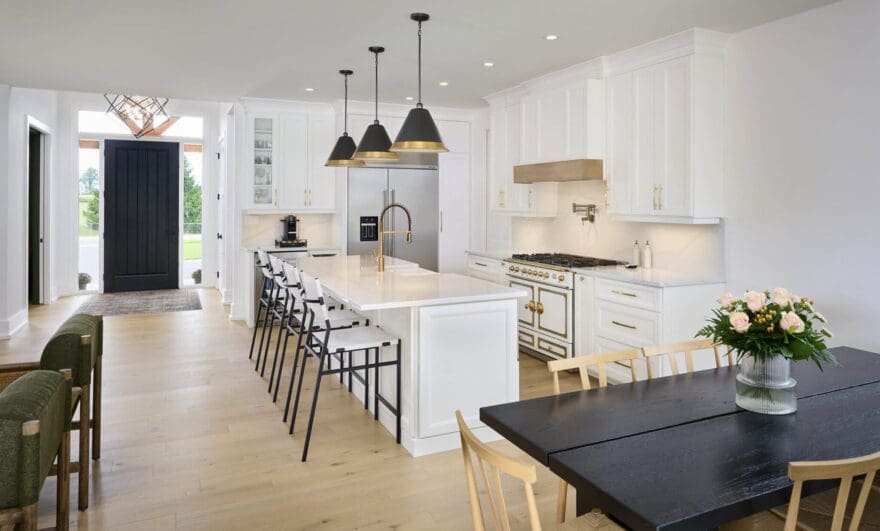
When building a high-end custom home, you expect every detail to reflect your vision — from the materials and craftsmanship to the final finishes. But even with the best architects, designers, and builders on your team, changes during construction are often inevitable.
In the world of custom home building in Ontario, change orders and change directives play a critical role in keeping the project on track, protecting both the client and the builder, and ensuring that every adjustment is properly documented.
Here’s what you need to know as a homeowner navigating a luxury custom build.
What Is a Change Order?
A change order is a formal, written agreement between the homeowner and the builder that modifies the original construction contract.
This can cover:
- Adding or upgrading materials (for example, switching to premium hardwood flooring or natural stone countertops)
- Modifying the design (such as adding a wine cellar or expanding a covered terrace)
- Adjusting the scope of work (like adding integrated smart home systems or custom millwork features)
In a custom home setting, where personalization is the entire point, change orders are common — and they allow the builder to provide a precise price and timeline impact before any work is undertaken.
Why Are Change Orders Important?
On high-end custom projects, the design often evolves as the client refines their vision. What looked perfect on paper may need fine-tuning once you see it framed on-site or after walking through the space.
The purpose of a change order is to:
- Define the additional cost or credit resulting from the change
- Clarify any impact on the project timeline
- Document agreement in writing to avoid misunderstandings or disputes
For homeowners, this ensures you know exactly what you are paying for and how each adjustment affects the final product. For builders, it provides a clear record so that no extra work is performed without proper authorization.
How Does the Change Order Process Work?
Here’s how change orders typically work in a luxury custom home project:
- A Change Is Identified
This might be initiated by the homeowner (for example, asking for upgraded lighting) or the builder (such as identifying the need for an additional structural beam after opening up a wall). - Scope, Pricing, and Timeline Are Determined
The builder prepares a formal change order document outlining:- A description of the change
- Additional or reduced cost
- Impact on the project timeline
- Any supporting details, drawings, or product specs
- Approval Before Execution
The homeowner reviews and signs the change order. Depending on the contract terms, the builder may require full payment or a deposit before proceeding. - Incorporation Into the Project
Once approved, the change is integrated into the construction schedule, and the cost is billed according to the contract — often as part of the next progress invoice.
What Is a Change Directive?
While change orders are planned and priced in advance, a change directive is used when a change must proceed immediately, even before the final price is determined.
This is typically used in situations where:
- There is an urgent site condition requiring immediate action (for example, addressing unexpected soil or drainage issues)
- There is a dispute over scope or pricing but work needs to continue to avoid project delays
The builder issues a written change directive that authorizes the work to proceed, with the understanding that final pricing will be determined later, often using a cost-plus model.
For homeowners, it’s important to know that change directives are meant to protect the project timeline, but they can introduce open-ended costs that must be settled later. Transparent communication with the builder is key to managing these situations effectively.
Why Do Change Orders Happen in Custom Home Projects?
Even with the most detailed plans, custom homes are complex, one-of-a-kind projects. Common reasons for change orders include:
- Evolving design preferences once the client sees spaces take shape
- Unforeseen site conditions or code requirements
- Material availability or upgrades
- Adjustments based on how adjacent design elements interact
In the luxury home market, where clients demand a highly tailored result, the design process is often fluid — and change orders are the mechanism that allows that fluidity to be properly managed.
Best Practices for Homeowners
To navigate change orders smoothly on a high-end custom build:
- Make Key Decisions Early
Finalize selections and upgrades before construction begins to minimize costly mid-project changes. - Understand Your Contract
Ensure you know how change orders and change directives are handled under your agreement — including builder markups, payment terms, and timeline impacts. - Request Clear Documentation
Insist on formal, written change orders for every adjustment. Verbal approvals can easily lead to misunderstandings. - Maintain Open Communication
Stay closely engaged with your builder and design team. Ask questions if you are unclear about costs or schedule impacts. - Keep a Personal Record
Track all approved change orders to maintain a clear understanding of your evolving budget and scope.
Final Thoughts
In the custom home building world, change orders are not just paperwork — they are an essential part of delivering the personalized, luxury result you expect.
Handled properly, change orders allow your home to evolve without compromising the budget, schedule, or client-builder relationship. The key is transparency, communication, and a shared commitment to quality.
If you’re preparing for a custom build, take time to understand how your builder manages changes and ensure you’re aligned on the process from day one. A well-informed client is the cornerstone of a successful, high-end project









